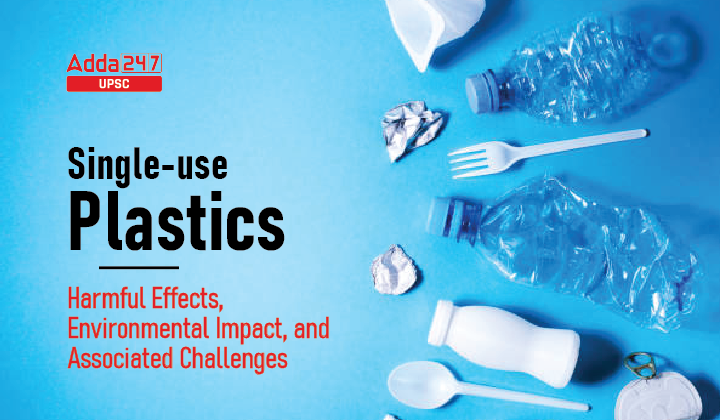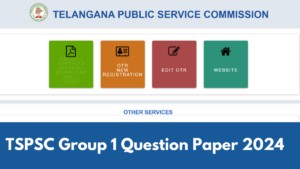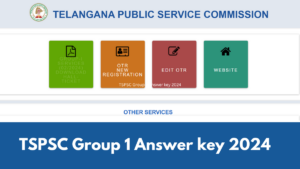Table of Contents
Single-use Plastics Ban- Relevance for UPSC Exam
- GS Paper 3: Environment- Conservation, environmental pollution and degradation.
Single-use Plastics in News
- The Plastic Waste Management Amendment Rules, 2021, prohibited the manufacture, import, stocking, distribution, sale, and use of plastic carry bags whose thickness is less than 75 microns.
What is Single-use Plastic?
- About: Single-use Plastic refers to plastic items that are used once and discarded. Single-use plastic has among the highest shares of plastic manufactured.
- A 2021 report by the Minderoo Foundation said single-use plastics account for a third of all plastic produced globally, with 98% manufactured from fossil fuels.
- Application: Single-use Plastics are used from packaging of items, to bottles (shampoo, detergents, cosmetics), polythene bags, face masks, coffee cups, cling film, trash bags, food packaging etc.
Harmful Effects of Single-use Plastics
- Environmental Impact: Plastic waste has drastic impacts on the environment and human health.
- Littered single-use plastic items have an adverse effect on both terrestrial and aquatic ecosystems.
- There is a greater likelihood of single-use plastic products ending up in the sea than reusable ones, badly affecting the ocean ecosystem.
- Green House Gas (GHC): On the current trajectory of production, it has been projected that single-use plastic could account for 5-10% of greenhouse gas emissions by 2050.
Indian Initiative at UN Environment Assembly
- India piloted a resolution on single-use plastics pollution at the 4th United Nations Environment Assembly in 2019, recognising the urgent need for the global community to address this issue.
- This resolution was adopted at the UN Environment Assembly as an important step forward.
- In the recently concluded 5th session of the United Nations Environment Assembly in March 2022, India engaged constructively with all member states to develop a consensus on a resolution to drive global action against plastic pollution.
Single-use Plastic Ban by Other Countries
- India is not the first country to ban single-use plastics. As of July 2019, 68 countries have plastic bag bans with varying degrees of enforcement.
- Examples:
- Bangladesh became the first country to ban thin plastic bags in 2002; New Zealand banned plastic bags in July 2019.
- China had issued a ban on plastic bags in 2020 with a phased implementation.
Plastic Waste Management Amendment rules 2021- Key Features
- Prohibition on manufacture, import, stocking, distribution, sale, and use of following single-use plastic:
- Earbuds with plastic sticks, plastic sticks for balloons, plastic flags, candy sticks, ice-cream sticks, polystyrene [Thermocol] for decoration;
- Plates, cups, glasses, cutlery such as forks, spoons, knives, straw, trays, wrapping or packing films around sweet boxes, invitation cards, and cigarette packets, plastic or PVC banners less than 100 micron, stirrers.
- Increasing the thickness of lightweight plastic carry bags: to 75 microns by September 2021 and 120 microns with effect from the 31st December 2022.
- This will also allow the reuse of plastic carry due to increased thickness.
- Extended Producer Responsibility of the Producer, importer, and Brand owner (PIBO): They will be responsible for collecting and managing plastic packaging waste in an environmentally sustainable way.
- The 2021 rules give legal force to guidelines for Extended Producer Responsibility (EPR) for ensuring its Effective Implementation.
Way Forward
- Awareness Generation: The consumer needs to be informed about the ban through advertisements, newspaper or TV commercials, or on social media.
- Investment in R&D: In order to find sustainable alternatives, companies need to invest in research and development.
- Collaborative Approach: The solution to the plastic pollution problem is not the responsibility of the government alone, but of industries, brands, manufacturers and most importantly consumers.
- Development and Promotion of Greener Alternatives: Finding alternatives to plastic seems a little difficult, however, greener alternatives to plastic may be considered a sustainable option.
- For example, compostable and bio-degradable plastic, etc., may be considered as an option.
Conclusion
- While the total ban on the use of plastic sounds a great idea, its feasibility seems difficult at this hour, especially in the absence of workable alternatives.
Plastic Waste Management Amendment Rules, 2021




 TSPSC Group 1 Question Paper 2024, Downl...
TSPSC Group 1 Question Paper 2024, Downl...
 TSPSC Group 1 Answer key 2024 Out, Downl...
TSPSC Group 1 Answer key 2024 Out, Downl...
 UPSC Prelims 2024 Question Paper, Downlo...
UPSC Prelims 2024 Question Paper, Downlo...





